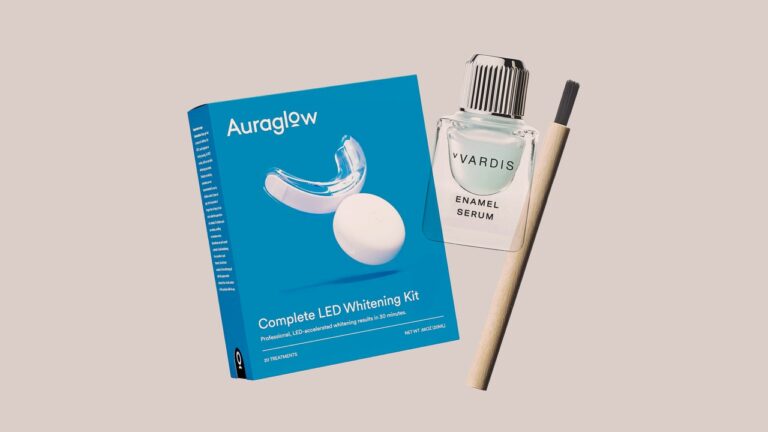Editor’s Tip: You have the option of a regular or sensitive version of the carbamide peroxide formula to choose from, the latter of which comes with a special desensitizing gel.
Key Ingredients: Carbamide peroxide | Who is it for: All
Frequent questions
How do you remove stains from teeth?
“Tooth enamel [is] a crystal” Matthew J. Messina, DDS, a board-certified, Ohio-based dentist and spokesperson for the American Dental Association (ADA), says. “If you were to look at tooth enamel under a very powerful microscope, [the structure] it looks like chicken wire” (or wire mesh). He explains that removing stains from the enamel matrix of the teeth is like removing the dirt stuck to the chicken wire: “So what happens in whitening is that we want to . . . open the die and get that color, stain, and then close it again.” That’s where the peroxide comes in.
How do teeth whitening ingredients work?
Dr. Messina says that peroxide causes this bubbling, so the active ingredient in the whitening kits you buy will be hydrogen peroxide or carbamide peroxide (a diluted version of hydrogen peroxide). “Carbamide peroxide is used because it is a relatively stable compound.” Neil Hadaegh, DDS, a board-certified cosmetic and restorative dentist in Beverly Hills, California says. “This helps the manufacturer ensure the quality and consistency of the product at the consumer’s end.” Dr. Messina notes that in addition to peroxide, over-the-counter whitening products usually contain some additional ingredients to improve the taste.
What are the differences between in-office whitening treatments and over-the-counter whitening treatments?
Peroxide is the main active ingredient in the products that dentists use to perform in-office and in-office whitening. The only difference is concentration. “If we do something where we can cover the gum tissue…where the gum tissue is protected, we can use a stronger whitening agent…because it’s only touching the teeth,” says Dr. Messina. “Something you use over the counter has the potential to touch the gum tissues or be swallowed. So we have to use a much lower strength of the active ingredient because … it can burn [the patient’s] gum tissues’.
Dentists who perform professional treatments, on the other hand, “can take all the necessary precautions to make sure that the gum tissue is safe and protected and that the whitening agent only gets into the enamel of the teeth that we want whiter.” Finally, Dr. Messina says that all over-the-counter peroxide-based bleaches will provide comparable results as long as you follow the manufacturer’s directions for use. It says you can use it for 7 to 10 days to start, then once every other week or so for maintenance.
Do you have other considerations when purchasing teeth whitening products?
Apart from this, Giri Palani, DDS, a board-certified dentist in Beverly Hills and Palos Verdes, California, says the most important thing to look for when shopping is ease of use. “Also, [you] you want to make sure the product you’re buying has a good shelf life and that you’re storing it properly in the fridge to make it last longer,” he says.
Am I a good candidate for over-the-counter teeth whitening products?
Before you do, however, consider making a trip to the dentist for your standard teeth cleaning and consulting on at-home whitening plans. “Teeth whitening is something that should only be done in a healthy oral state,” she says. “If someone has tooth decay or periodontal disease or some other reason why their teeth are not white, whitening is not the right choice for them. That’s why it’s always a good idea to have a thorough examination by your dentist before starting a whitening program.”


